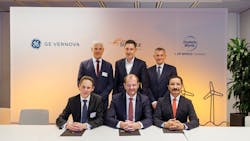GE Vernova Awarded Ostwind 4 Project to Build 2 GW Offshore Grid Connection in German Baltic Sea
GE Vernova, in consortium with Drydocks World, has been awarded the Ostwind 4 project by 50Hertz, a German Transmission System Operator (TSO), to design, construct and commission a 2 GW HVDC electric transmission system in the German Baltic Sea, connecting an offshore wind farm to the German grid.
The Ostwind 4 project, located in the Arkona Basin, approximately 30 km northeast of Rugen Island, will transport up to 2 GW of offshore wind energy through the HVDC system to the mainland, delivering renewable electricity equivalent to the amount required to power nearly two million households.
The project is expected to include an advanced bipolar HVDC transmission system operating at 525 kV, ensuring efficient energy transport with minimal losses over long distances. It is provisionally slated for completion by the end of 2031.
While GE Vernova will supply advanced HVDC technology, including voltage-sourced converters (VSC), high-voltage transformers, g3 gas-insulated switchgear (GIS), air-core reactors, as well as civil works for the onshore converter station and grid automation telecommunications equipment, Drydocks World will be responsible for designing, fabricating, and installing the offshore converter platform, including the jacket substructure and topside.
The advanced infrastructure, built at Drydocks World’s Dubai facility, features a U-shaped jacket substructure with integrated nature-inclusive scour protection to enhance marine biodiversity while minimizing environmental impact.
The project will also benefit from GE Vernova’s new HVDC Competence Center in Berlin, which is focused on developing technology to improve grid stability and integrate more renewable energy.
Germany is following its Energiewende framework, which aims to phase out coal by 2030 and achieve net zero emissions by 2045. As per the German Climate Law, 80% of electricity supply is expected to come from renewable sources by 2030, with a target of 100% by 2035.
Projects like Ostwind 4 will help meet these goals, enabling the efficient transmission of renewable energy from offshore wind farms to the national grid and reducing dependence on fossil fuels.
